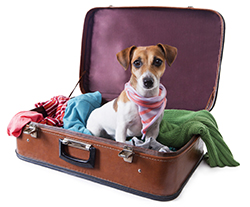
Dogs are part of the family, which is why many people choose to take their beloved pets on trips and vacations with them. But travelling with pets can come with its challenges. This article will guide you in what you should do before travelling with a dog.
Travelling With A Dog By Car
Most dogs love going for car rides and many people are quick to throw them in the back with the window rolled partially down. But even Fido should fasten up. Dogs can become projectiles in the event of a collision, putting his or her life as well as the lives of everyone in the vehicle at risk.
It's recommended you restrain your dog in some fashion either through a pet restraining device such as a harness, a hard-sided pet travel crate or soft travel crate, pet vehicle seats or by using vehicle barriers.
- Related Read: Riding In Cars With Pets: The Lowdown on Accidents, Distractions and Auto Insurance
- Related Read: How To Travel With A Cat
Before travelling with your dog by car, you're going to want to:
- Get your dog used to travelling via car by taking her out for a few test rides. Help her get accustomed to her restraining device by talking to her in a normal voice. This will help prevent her from getting anxious.
When travelling, make sure you:
- Bring her favourite toys to help keep her calm
- Take regular breaks so she can use the washroom and stretch her legs
- Take her for a walk as soon as you arrive
Travelling With A Dog By Plane
The first thing you're going to want to do-before you even book a flight-is make sure the air carrier allows for the transportation of pets. While most have some system in place, it's important to check what's involved before you confirm your itinerary. It's also important to note that not all airlines allow pets into the country.
Different airlines will have different policies and procedures, and depending on the size of the dog, may offer different travel options. There are generally three main ways your pet can travel with you:
- In the cabin at your feet in a crate (soft sided are often recommended)
- In the checked baggage compartment on the same flight as you
- Shipped alone via air cargo
The method you choose will in part depend on the size of your dog. Generally the dog and crate weight combination cannot be more than the average carry on bag. Some flights may have restrictions on the weight of the pet carrier and dog combined for the checked baggage option. For example, Air Canada's maxes out at 70 lb. You may have to ship your pet through air cargo if your dog is larger than the permitted weight and carrier sizes.
Service charges may apply for travel each way.
The airline may also require a certificate of health before permitting a dog to travel by plane. The level of certificate may vary depending on where you're travelling. Some countries require a health certificate obtained through an embassy.
Travelling With A Dog By Train
Like planes, check with the train company's pet policies before you book a ticket. Many trains allow pets to travel, but often they're not permitted in the passenger trains and must be kept with baggage. It's important to ensure you book a train that accepts baggage and pets.
Via Rail, for example, operates this way. While they have no weight limits for animals, they may require you to do the heavy lifting if your dog and cage weight combined totals more than 70 pounds. Certain destinations allow you to visit your pet from time to time when accompanied by a Via employee.
As with planes, you will likely have to pay a fee each way to bring your dog with you on a journey by train.
Keep Calm and "Carry On"
When saying goodbye to your dog, it's important you talk to her in your normal voice. Dogs respond to people's emotions and body language and if you speak in a sad or concerned voice, your dog may become sad and concerned as well, making her anxious throughout the duration of the trip. It's best to be positive so he or she doesn't worry as much.
Protect Your Pup When You Travel
You've packed their toys and their favourite snacks; now make sure you don't forget your pet insurance.
Pet insurance is especially important when you're travelling with your dog. When it comes to your auto insurance, for example, pets are not considered passengers and thus any medical bills resulting from a collision will not be covered. If another driver is at-fault, you might have a case through a third party suit, but it's best if you have your own insurance in place to protect your dog.
Many pet insurance policies protect animals while travelling. But, check with your pet insurance provider before you head out to be sure. Policies and coverage varies, but it's typical for policies to only allow for claims from registered veterinarians in the Continental United States and Canada only.
Compare coverage and rates for pet insurance today at Kanetix.ca.




